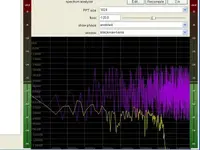OK, now I can read the numbers...but only after dragging it into Photoshop and adjusting the levels. Man, I've been discovering lately that I seem to keep my monitor much darker than most other folks; I don't see how you guys can stare at such bright lightbulbs so long

.
I assume the yellow graph represents the hum. I'm not sure what that magenta line is all about. Anyway, Rokket Man, assuming the yellow line, that's quite a bit of noise you have there, and it's not just a simple fundamental and harmonics. You do have a small series of fairly wide bumps at approximately 150, 300 and 600 Hz which could be related, with another possibly related one at about 750Hz, though that's kind of a stretch. Everything else above that seems fairly noisy to me, with no obvious patterns sticking out.
The fact that the noise runs all the way from DC to approx, 7-8kHz, with not much pattern above the upper bass is bothersome to me in that a NR plug like what Benny wants to try may take out a lot of the signal as well. But the only way to know for sure is to give it a shot.
Other than Ben's approach, which I would still pursue, what I'd probably do in my circumstance would be to throw RND's Uniqualizer at it, allowing me to run several simultaneous EQs and filters at it in one pass. I have one run a high pass at about 150Hz or so, and then set up a harmonic filter with fairly wide Q to match the bump widths in the graph with a fundamental around 150Hz (adjusting the exact value to exactly fit the curves).
Then with what's left I'd either run it through NR* or I'd hit it with an expander set to maybe about 1:3 and a threshold of about -70dB.
*Note to Benny: I have had situations in the past where, if the NR winds up artifacting the good signal too much, that sometimes just taking out some of the obvious stuff with targeted EQ first is good enough to let the NR take care of the rest w/o artifacting the signal. Of course, if you're not getting artifacting, then don't worry about it

.
G.


 .
.

